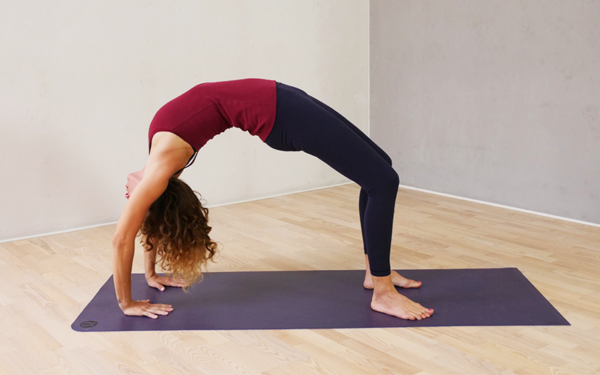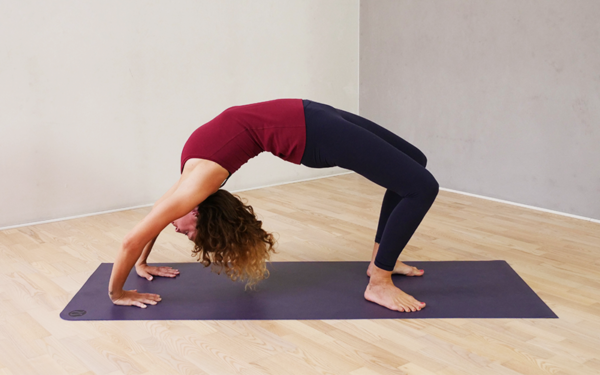Wheel pose: Open your shoulders and your heart with a yoga bridge
 ©Vladimir Sukhachev
©Vladimir Sukhachev
Wheel pose, also sometimes called a yoga bridge or bridge pose, is one of the most common yoga poses. Known to open the heart and upper body, it’s an asana that may help improve flexibility in your back. Below, find out all about how to do it and the intermediary workouts you can do to prepare yourself.
What is wheel pose?
Wheel pose, or Urdhva Dhanurasana in sanskrit, is a yoga pose that falls under the backbend umbrella. Also known as upward bow pose, or Chakrasana, your body takes the shape of an arched bow in it, as the name suggests.
In the pose, body weight should be evenly distributed over the hands and feets. Arms should be outstretched and the upper body should be arched upwards. The belly button should be at the highest point. Going upside down like this gives you a completely new point of view, and it can produce some unfamiliar sensations in your body as a whole, especially the first few times you try it.
It’s a pose that’s known to mobilize your entire spine, strengthen your muscles, and improve flexibility in your entire body. It’s not an easy pose, though, so it’s essential to warm up beforehand to ensure you’re prepared.
Are you just beginning your yoga practice? Do you spend a lot of time seated or hunched forward? Are you recovering from a back injury? In these cases, wheel pose may be extremely difficult or even impossible for you to do. Luckily, there are plenty of ways to modify the pose to best suit your needs. Half wheel is an excellent warm-up exercise to prepare your back for the full pose and a great exercise in its own right if you don’t feel like or can’t go further.
Whenever you’re doing physical activity, whether that be yoga, running, swimming, or something else, it’s important to stay sufficiently hydrated. Hot drinks can be especially beneficial for your digestive system, and a good herbal tea will help you to rehydrate and relax before or after your workout.
Benefits of Wheel Pose
Urdhva Dhanurasana can have many positive effects on the body and mind. You don’t even need to go into the deepest form of the pose to reap its benefits.
Wheel pose can help:
- stretch the entire front of the body, especially the chest, abdomen, hip flexors, and thighs
- stretch the entire back
- strengthen arm muscles, upper back muscles, calves, hands, and feet
- activate the organs in the abdomen
- stimulate blood circulation
- strengthen will and discipline
- open up the diaphragm
- open your eyes to a new perspective
If you are not yet ready for full wheel pose, you’ll still get these same benefits from modified versions like half wheel. Find out how to do them below!
How to do a wheel pose in yoga
Urdhva Dhanurasana can be easy to learn if you’re already flexible and strong, but it can also take months to achieve if you’re not. Whatever you do, don’t rush yourself, especially in this pose. Take the time to learn the correct form to prevent injuries and ensure benefits.
Even if you can go straight into a full wheel pose, it’s still a good idea to become familiar with the modifications. Everything that’s important in full wheel, like the alignment of the arms and legs, is also just as important in its alternatives.
Supported bridge
Supported bridge opens the front of the body and strengthens the glutes, lower back, and the back of the legs. Your arms lay flat on the ground and the focus is on opening your shoulders and hips.
- Lie on your back, bend your knees and put your feet on the ground, as close to your glutes as possible. Your knees and feet should form right angles with your ankles. Make sure you can touch your heels with your fingertips. Keep your hands free.
- From your pelvis, raise your abdomen, vertebra by vertebra along your spine, until only your shoulders are on the ground.
- With both hands, grasp the edges of your mat and spread the mat apart. Feel which muscles are activated, and use these muscles to bring your shoulder blades together.
- Stay in this position or clasp hands to bring your shoulder blades a little closer together. Keep your elbows slightly bent and your hands on the floor.
Half Wheel
- Repeat the same steps for supported bridge pose.
- Instead of placing your hands under your pelvis, place them flat next to your ears with your fingertips pointing towards your feet, as if you were going to do a full wheel. Keep elbows straight and arms parallel. If you’re struggling with this step, find out why and fix it before moving on to the next.
- Roll your head backwards so that the top of your skull touches the ground between your hands. Push firmly on the floor with your hands and feet to remove as much weight as possible from your head. Re-adjust your arms. Elbows should point backwards and arms parallel.
- When you feel safe and comfortable and nothing hurts – and only then – push upwards, stretching your arms little by little to get into a full wheel position. This could take a while to achieve, so don’t rush it!
How to do this pose properly
This complex pose requires a lot of concentration and practice. Take the time to learn it properly. In the photo below, yoga teacher Jenny demonstrates what a successful wheel pose will look like. Mastering it will better enable you to focus more on your body, breathing, and the sensations you experience in your entire yoga practice.

Chakrasana: things to remember
- Feet should be anchored to the ground, pointing straight ahead, and parallel to each other.
- Knees should be directly above the ankles.
- Lower back should be extended.
- There shouldn’t be any pressure in your lower back.
- Chest should push forward and upward.
- Neck should be relaxed.
- Fingertips should be pointing towards the feet.
- Hands and arms should be shoulder-width apart.
- Hands should be actively pushing towards the ground, fingers spread apart.
Common mistakes to avoid
Wheel pose is a great exercise for improving mobility of the spine and preventing posture problems, but only when done correctly. Regularly taking shortcuts or making mistakes in this pose increases your risk of neck, back, or spine injury.
The thoracic spine, or the part of the spine that is in line with the rib cage, is naturally more flexible than the lumbar spine, or the lower part of your back. Spending a lot of time seated or hunched over can dramatically increase the level of immobility in this part of your back, which may make it more difficult to achieve a full Urdhva Dhanurasana.
Because the different parts of the musculoskeletal system are connected to each other, your lower back automatically compensates for the lack of mobility in your upper back. In regards to wheel pose, this may mean you have a harder time opening your chest and shoulders, even if you’re pushing yourself as far upwards as you can.
Pushing yourself into the fullest version of the pose before you’re ready will completely eliminate the benefits you’d get from it. Instead, you run the risk of injuring yourself and reinforcing existing bad posture. Take the time to learn how to do this pose correctly. And find out all the mistakes to avoid below.

| Mistake: | Feet are pointing outward. |
| How to avoid it: | Place your feet parallel to one another. |
| Tip: | Take the time to find the right position for your feet. If something doesn’t feel right, move your feet until you find the right spacing and then anchor them firmly to the ground. |
| Mistake: | Thighs fall to the side. |
| How to avoid it: | Consciously bring your thighs back towards the center. |
| Tip: | Place a block or a ball between your legs and hold it for the duration of the pose. |
| Mistake: | Glutes are too tight. |
| How to avoid it: | Make sure your legs, feet, and arms are doing all the work. |
| Tip: | Try to push your feet into the floor, as if you were trying to stretch your mat, but without moving it. This activates your legs automatically. |
| Mistake: | Arms fall outward/ shoulders are compressed. |
| How to avoid it: | Return to supported bridge pose and place your head on the mat. Focus on maintaining this form while aligning and extending your arms. |
| Tip: | Be patient with wheel pose and its modifications, giving your body time to adjust. If you can’t seem to get comfortable no matter what you do, ask your yoga instructor to show you other variations that can help prepare you. |
| Mistake: | Neck and spine are tense. |
| How to avoid it: | Relax your neck by letting your head hang simply without resistance. |
| Tip: | Scan your body from head to toe, like a CAT scan, and identify where you are consciously tense and relaxed. If this doesn’t work, then continue to practice an easier variation of the posture. It’s normal for it to be tiring, but you don’t want to be too tense – this is what leads to injuries. |
Wheel pose: Our conclusion
- Wheel pose is also called Urdhva Dhanurasana in Sanskrit or upward bow pose.
- It stretches the body and improves mobility of the spine.
- Body weight must be evenly distributed to achieve correct execution of the pose.
- Because it’s a demanding asana, it’s a good idea to warm up with preparatory poses.
Sources for this article
We at foodspring use only high-quality sources, including peer-reviewed studies, to support the facts within our articles. Read our editorial policy to learn more about how we fact-check and keep our content accurate, reliable, and trustworthy.



























